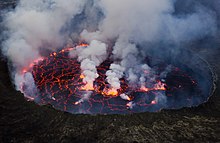Volcanogenic lake

A volcanogenic lake is a lake formed as a result of volcanic activity.[1] They are generally a body of water inside an inactive volcanic crater (crater lakes) but can also be large volumes of molten lava within an active volcanic crater (lava lakes) and waterbodies constrained by lava flows, pyroclastic flows or lahars in valley systems.[2] The term volcanic lake is also used to describe volcanogenic lakes, although it is more commonly assigned to those inside volcanic craters.[3][4][1][2]
Volcanic crater lakes

Lakes in calderas fill large craters formed by the collapse of a volcano during an eruption. Examples:

Lakes in maars fill small craters where an eruption deposited debris around a vent. Examples:
- Lake Nyos, Northwest Region, Cameroon
- Lac Pavin, Puy-de-Dôme, France
- Soda Lakes, Nevada, United States
Lava lakes

These are some examples of rare lava lakes where molten lava in a volcano maintains relative equilibrium, neither rising to overflowing nor sinking to drain away.
- Mount Erebus, Ross Island, Antarctica
- Erta Ale, Afar Region, Ethiopia
- Mount Nyiragongo, North Kivu, Democratic Republic of the Congo
Lava-dammed lakes

- Lake Balık, Ağrı Province, Turkey
- Lake Disappear, North Island, New Zealand
- Garibaldi Lake, British Columbia, Canada
- Lake Güija, Guatemala/El Salvador
References
- ^ S2CID 129792354.
- ^ ISBN 978-3-642-36832-5.
- ^ Robert K. Lane, Lake at the Encyclopædia Britannica
- ^ Pasternack, Gregory B. "Volcanic Lakes". Pasternack Lab. University of California, Davis. Retrieved 2019-11-20.
Further reading
- Delmelle, Pierre; Bernard, Alain (2000). "Volcanic Lakes". In ISBN 978-0-12-643140-7.
- Christenson, B. W. (2000). Varekamp, Johan C.; Rowe, Gary L. Jr. (eds.). "Crater Lakes". Journal of Volcanology and Geothermal Research. 97 (1–4): 1–508. . (entire volume about crater lakes)
- Pasternack, G. B.; Varekamp, J. C. (1997). "Volcanic lake systematics I. Physical constraints". Bulletin of Volcanology. 58 (7): 526–538. S2CID 140598280.
- Kusakabe, Minoru, ed. (1994). "Geochemistry of Crater Lakes". Geochemical Journal. 28 (3): 137–306. . (entire issue about chemistry of crater lakes)
External links
- IAVCEI Commission of Volcanic Lakes
- IAVCEI Commission of Volcanic Lakes: Some fundamentals about Crater Lakes
- The Science of Volcanic Lakes
- Volcanic Lakes of the World
- USGS Hawaiian Volcano Observatory: Water on volcanoes: heavy rain and crater lakes
- USGS Cascades Volcano Observatory: Volcanic Lakes
- The Science of Volcanic Lakes, Greg Pasternack, U. California Davis
- Crater Lake National Park documentation in Building Oregon: Architecture of Oregon & the Pacific Northwest archive
- World Volcanic Lakes Map
